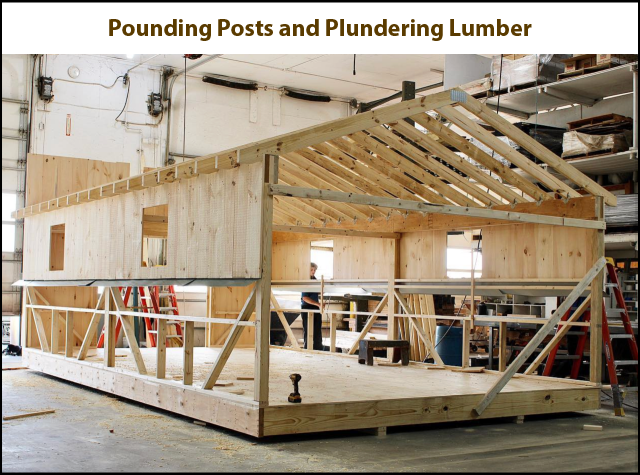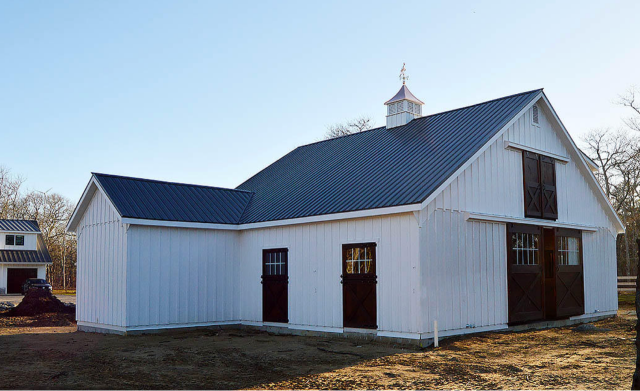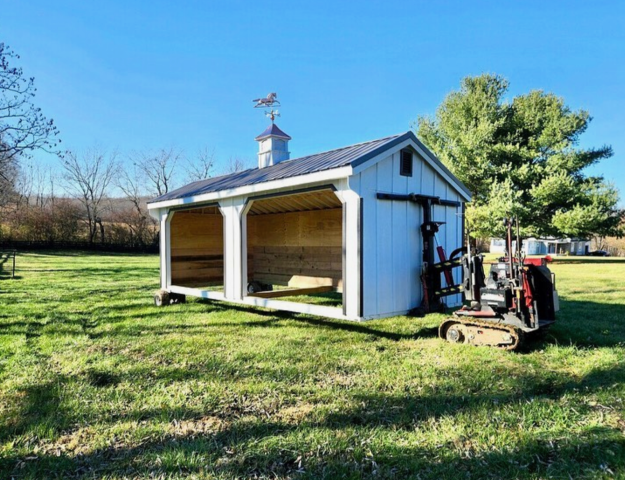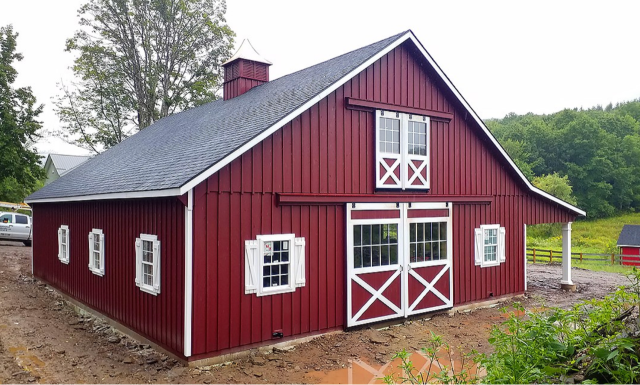Pounding Posts and Plundering Lumber
by Nikki Alvin-Smith

The most common reason folks make the decision to build a horse barn or run-in shed on a do-it-yourself basis is the notion that it will save them money. When it comes to construction of a horse barn the cheap option is not always what it seems, and neither is it always the best means to achieve the best result.
Aside from the high risk of cost overruns, poor workmanship, and errant design decisions due to a lack of knowledge, and the very real concern of personal injury, departure from the original mission of the property owner to save on expenses is often the result of a D-I-Y project when it involves something that is the scope of a large structure like a horse barn.
The bigger the project the more expensive it will be at the outset as it necessarily requires more materials and more labor to complete. It’s one thing to consider renovating a bathroom or repainting a living room, and quite another to contemplate raising a two-story center aisle barn or Monitor barn.
Even those projects that are sized in between such as a 10’ x 20’ run-in shed are going to require work on ladders and a pile of materials to be delivered on site to complete the task. And don’t forget all the tools needed. Compressors to run nail guns or high impact drills may be needed if no electrical source is handy and battery powered tools are not heavy duty enough for the job. A hammer and nails and a hand-drill for bolts is a very hard way to go about construction and have aged out of use for good reason.
Material Matters In Design
The design element of any building is an important step in the planning process. Not just because of the permit or zoning requirements, wind or snow load provisions, or matters of sensibility, but because the design directly relates to the cost and function of the barn.
A good example of material mismanagement in design, is a poor decision made on the height of the lowest exterior wall of the barn. Depending on the siding being utilized, whether the interior walls will include a knee wall or wood cladding, the minimum height that suits an average horse of 10’, may constitute the need for purchase of multiple sheets of sheathing materials that need to be cut on site, versus manufactured lengths. Every time a piece of wood is cut, wastage of the product will result. Similarly for stall widths, when boards are being bought by standard board lengths of 8’, 10’ or 12’ it makes little sense to have odd sized stalls at 9’ or 11’.
However, consideration for interior wall sizes versus exterior wall sizes is needed. If posts are set on center {O.C.} 12’ apart, the interior dimension of a stall will not be 12’, it will be less.
A well-designed barn will be constructed with a view not just to the aesthetic of the interior or exterior of the building, its usability and function, but also the size and placement of the infrastructure will be keenly viewed with an eye to minimizing wastage of materials. There is less likely to be a ‘plundering of lumber’ if good design practices are followed.
The type of construction materials used will also be approached with care. While low maintenance and easy-care products are popular, their fit and usefulness in any particular application will be evaluated for both wastage and overall cost effectiveness.
There are road maps that engineers and architects have spent much time, money, and effort to navigate in the realm of construction. Their expertise is important for good reason. Think of a horse barn as a large jigsaw of pieces that have to be put together not just in the right order, but also the need for the right pieces to be in the box before the construction process begins.

The Reason For Estimates Versus Quotations
The design of the barn can be perfect in regard to minimizing the wastage of product, but the folks building the structure (who may or may not have plans to follow or know how to use them) may not follow directions properly. This inaccuracy necessarily results in wastage of materials, often also a mismanagement of time on the job. In turn this raises costs for both labor and materials and the project will take longer than promised to finish. Hence the common practice for on-site building projects to be costed by construction companies as estimates not quotations, (and certainly not ‘to the penny’ quotes as you would garner from a modular building company).
Factor in weather delays, material substitutions due to availability of products shopped for on spec (further increasing the likelihood of wastage and cost overruns), and it is easy to see why construction companies are reluctant to offer any building contract without an ‘out’ clause on both price and project completion timeline.
On site horse barn builds often utilize a pole barn construction. As the soil types, topography, depth of bedrock and other factors are unknown, even the length of the lumber to be installed as posts has to be estimated. Before the project begins on site no one knows how far down posts can be successfully pounded or how deep a hole for a supporting pillar can be excavated or hand or auger dug. Unknown variables always add expense to any project.
Crafting A Good Build
Construction teams that are used to working together on a daily basis, especially those working on the same or similar builds day after day have established a rhythm of working together in concert. Certain crew members may have strengths in one job while others are craftsman in other areas and each person is assigned to specific tasks that they have the talent to execute correctly.
In a factory or modular build setting, not only are the tools and materials on hand for all needs of the project, but the human hands that craft the materials together are likely experienced and professional at their task. This ultimately results not just in a better job, but a better cost basis.
A good example is the application of sheathing to a roof. A good roofer will know how to cut the right angles and know where to start. Of course, if the building is out of square, that few inches that ‘didn’t matter’ to the property owner completing the DIY project on the deck level suddenly matters a lot more when it gets 10 to 20 feet up in the air. The roofer has to deal with these variances.
A good roofer will measure twice and cut once, and importantly know what to measure where and relay that information to a person on the ground that will likely be tasked with making the cut. Miscommunications or lack of knowledge on the part of any team member will result in excess wastage of expensive sheathing.
Construction of an accurately measured corner to corner building that is ‘square’ as well as ‘plumb’ is much easier to execute when the structure is produced on a level concrete factory floor than out in the field.
Why Weather The Weather?
Weather can also affect the quality of the materials purchased. While lumber may be good quality straight posts or boards when delivered to the site, if they sit out in the sun or rain or even adverse heat or dampness, warpage may result. This may make them either useless, less functional or during installation they may require application of pressure resulting in stress fractures or cracking.
Cost wise poor weather can also affect when and how successfully stains and paints can be applied and their durability, as well as cause delays in their application.
Good Reasons To Go Modular
Aside from the above great reasons to choose a ‘to the penny’ quoted modular build over an on-site build, the ease of purchase and quick and easy set-up of a modular horse barn make it an attractive alternative to a DIY project.
Experienced professionals in the business, such as leading modular horse barn producer Horizon Structures, who have a nationwide footprint and can service clients anywhere in the Continental U.S., offer other benefits of use due to their customer service team’s wealth of knowledge.

“There are many areas in barn design where costs can be saved and working with the client on how to accomplish their budget needs are all part of our job,” says veteran C.M.O. at Horizon, Jill Siragusa. “Our friendly staff are good listeners and are always up to accommodate special needs for problematic site issues, financial constraints, and common obstacles to owning their dream barn that our customers face. We offer financing options, multiple building purchase discounts, and many other services including returning to move run-in sheds if needed once a new property owner has their ‘ducks in a row’. Every project is different, and we treat everyone as an individual. Their ultimate satisfaction with their new horse barn is always our highest priority. Happy horses, happy clients, that is what we are all about.”



